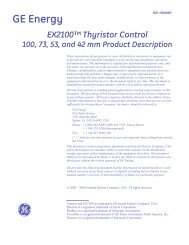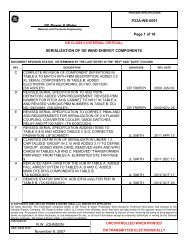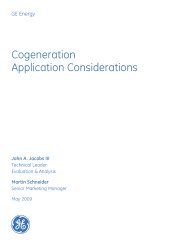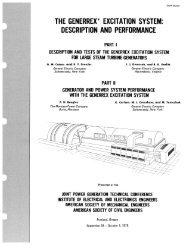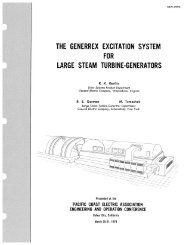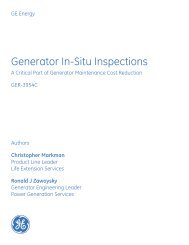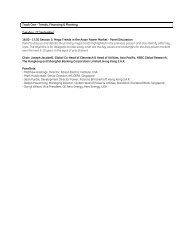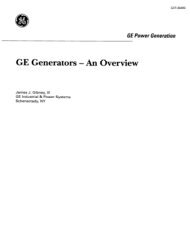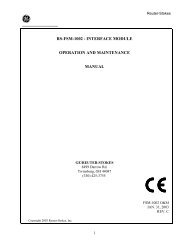GER 3568G - Dry Low NOx Combustion Systems for ... - GE Energy
GER 3568G - Dry Low NOx Combustion Systems for ... - GE Energy
GER 3568G - Dry Low NOx Combustion Systems for ... - GE Energy
You also want an ePaper? Increase the reach of your titles
YUMPU automatically turns print PDFs into web optimized ePapers that Google loves.
<strong>Dry</strong> <strong>Low</strong> NO x <strong>Combustion</strong> <strong>Systems</strong> <strong>for</strong> <strong>GE</strong> Heavy-Duty Gas Turbines<br />
limited. A team of engineers from <strong>GE</strong> Power<br />
<strong>Systems</strong>, <strong>GE</strong> Corporate Research and<br />
Development and <strong>GE</strong> Aircraft Engines proposed<br />
a design that repackaged DLN-1 premixing<br />
technology but eliminated the venturi and<br />
centerbody assemblies that require cooling air.<br />
The resulting combustor is called DLN-2, which<br />
is the standard system <strong>for</strong> the 6FA, 7FA, and 9FA<br />
machines. Fourteen combustors are installed in<br />
the 7FA, 18 in the 9FA, and six in the 6FA. Two<br />
additional variants of the DLN-2 system have<br />
been developed to meet the additional design<br />
requirements imposed by either new machine<br />
cycles or reduced emissions levels. These combustors,<br />
the DLN-2.6 and the DLN-2+, will be<br />
described briefly in later sections.<br />
DLN-2 <strong>Combustion</strong> System<br />
The DLN-2 combustion system shown in Figure<br />
13 is a single-stage dual-mode combustor that<br />
can operate on both gaseous and liquid fuel.<br />
On gas, the combustor operates in a diffusion<br />
mode at low loads (< 50% load), and a premixed<br />
mode at high loads (> 50% load). While<br />
the combustor can operate in the diffusion<br />
mode across the load range, diluent injection<br />
would be required <strong>for</strong> NO x abatement. Oil<br />
operation on this combustor is in the diffusion<br />
mode across the entire load range, with diluent<br />
injection used <strong>for</strong> NO x control.<br />
Figure 13. DLN-2 combustion system<br />
Each DLN-2 combustor system has a single<br />
burning zone <strong>for</strong>med by the combustor liner<br />
and the face of the cap. In low emissions operation,<br />
90% of the gas fuel is injected through<br />
radial gas injection spokes in the premixer, and<br />
combustion air is mixed with the fuel in tubes<br />
surrounding each of the five fuel nozzles. The<br />
premixer tubes are part of the cap assembly.<br />
The fuel and air are thoroughly mixed, flow out<br />
of the five tubes at high velocity and enter the<br />
burning zone where lean, low-NO x combustion<br />
occurs. The vortex breakdown from the swirling<br />
flow exiting the premixers, along with the sudden<br />
expansion in the liner, are mechanisms <strong>for</strong><br />
flame stabilization. The DLN-2 fuel nozzle/premixer<br />
tube arrangement is similar in design<br />
and technology to the secondary nozzle/centerbody<br />
of a DLN-1. Five nozzle/premixer tube<br />
assemblies are located on the head end of the<br />
combustor. A quaternary fuel manifold is located<br />
on the circumference of the combustion casing<br />
to bring the remaining fuel flow to casing<br />
injection pegs located radially around the casing.<br />
Figure 14 shows a cross-section of a DLN-2 fuel<br />
nozzle. As noted, the nozzle has passages <strong>for</strong> diffusion<br />
gas, premixed gas, oil and water. When<br />
mounted on the end cover, as shown in Figure<br />
15, the diffusion passages of four of the fuel<br />
nozzles are fed from a common manifold,<br />
called the primary, that is built into the end<br />
cover. The premixed passages of the same four<br />
nozzles are fed from another internal manifold<br />
called the secondary. The pre-mixed passages of<br />
the remaining nozzle are supplied by the tertiary<br />
fuel system; the diffusion passage of that<br />
nozzle is always purged with compressor discharge<br />
air and passes no fuel.<br />
Figure 15 shows the fuel nozzles installed on the<br />
combustion chamber end cover and the connections<br />
<strong>for</strong> the primary, secondary and tertiary<br />
fuel systems. DLN-2 fuel streams are:<br />
<strong>GE</strong> Power <strong>Systems</strong> ■ <strong><strong>GE</strong>R</strong>-<strong>3568G</strong> ■ (10/00) 9



